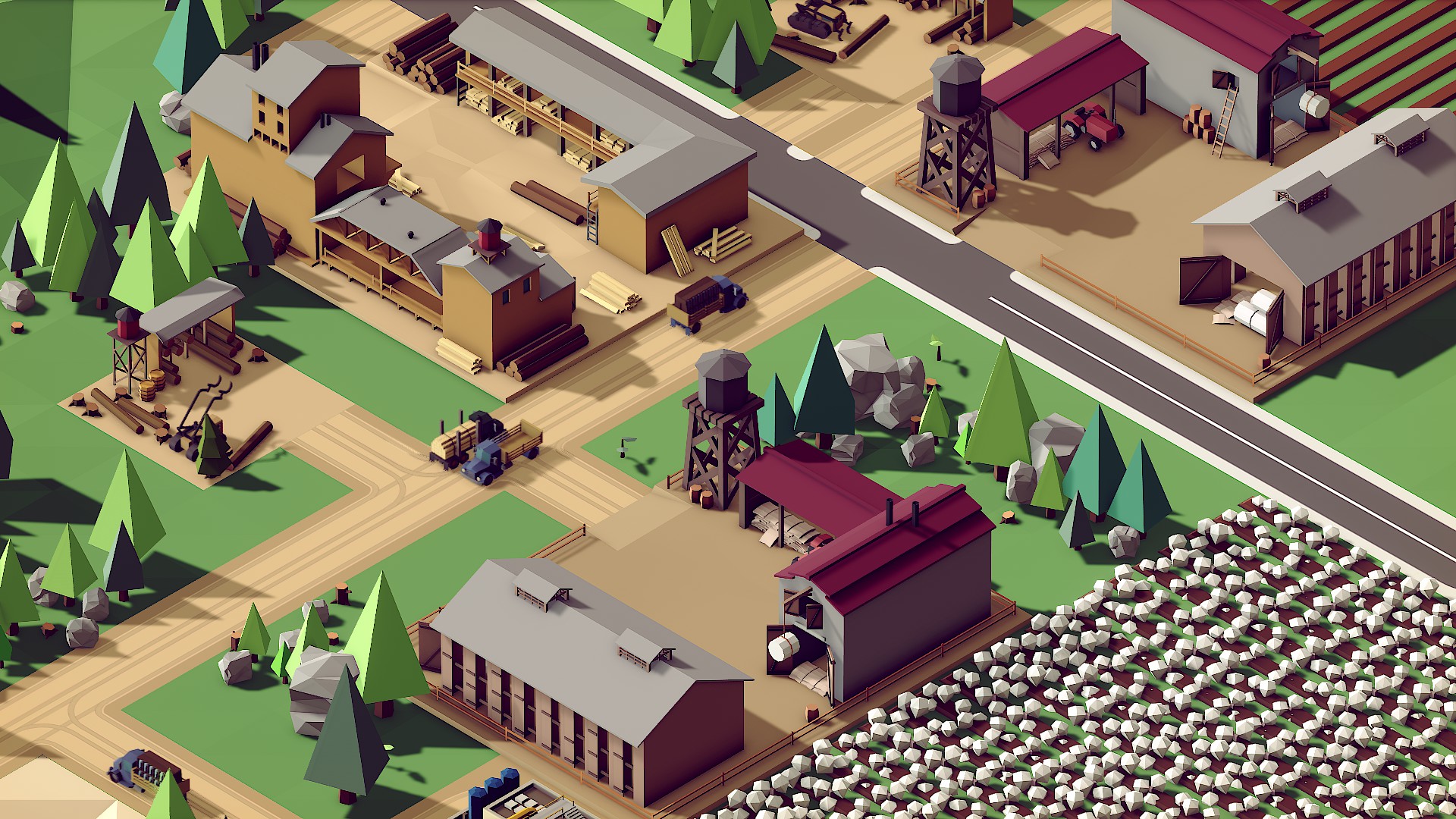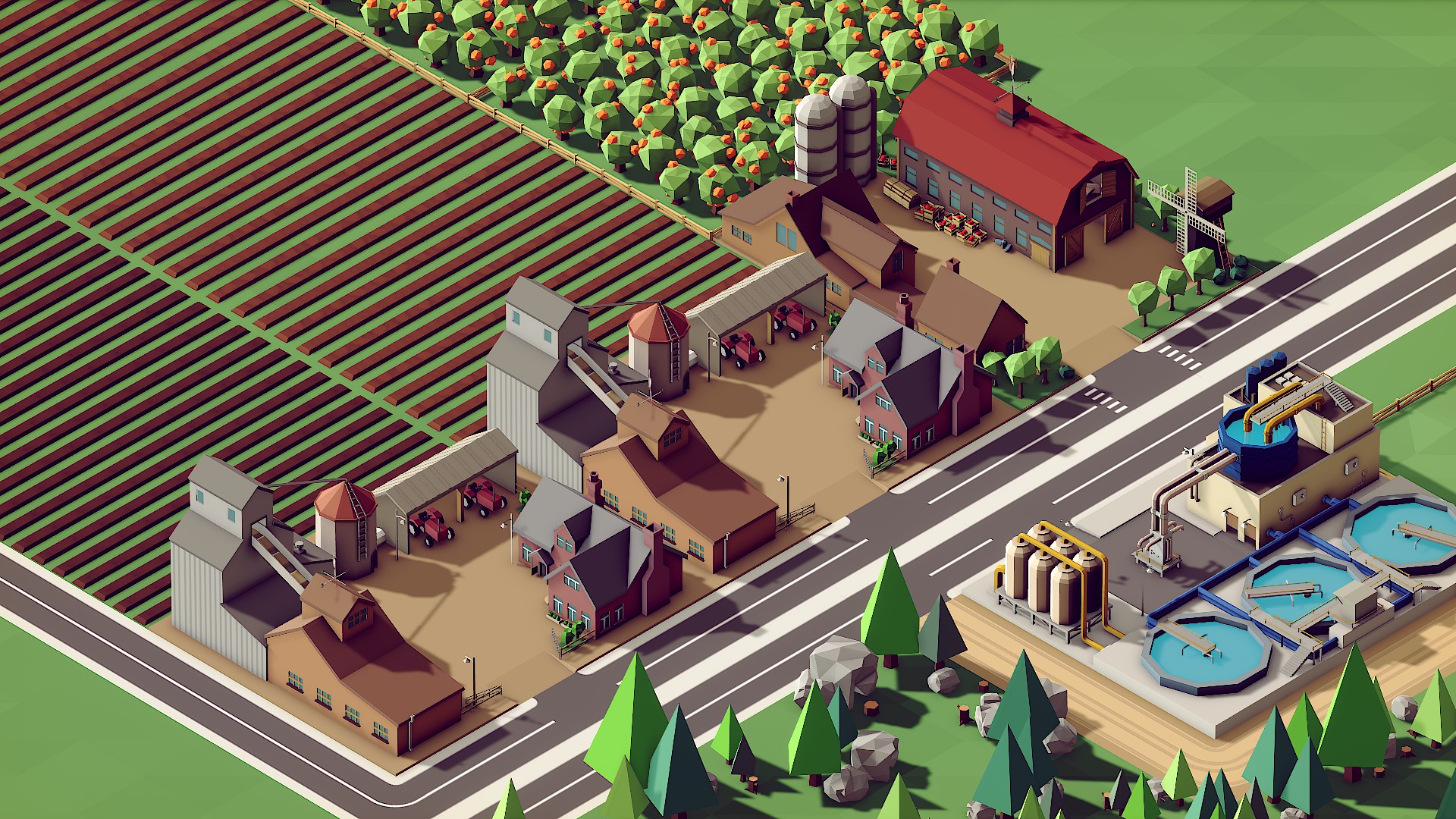Rise of Industry Guide – Beginners Tips & Tricks
Rise to the top with our handy beginner’s guide.

After a long period in Alpha and Early Access, Rise of Industry has finally released into v1.0. If you’re just getting started in the business tycoon sim, or perhaps returning to it now that it’s been updated, check out our guide for lots of tips and tricks for how to make your commerce go as smoothly as possible. We’ve got advice on the basics of getting started, where to build, how to make and save money and much more.
Rise of Industry controls & keyboard shortcuts
Movement/camera
- WASD/arrow keys – Move camera. Hold shift to move faster
- RMB/Scroll button – Hold to pan
- Q/E – Rotate camera 90 degrees clockwise/anti-clockwise
- Scroll wheel/PgUp, PgDown – Zoom in and out
- F10 – Free cam mode
- C/F – Move camera up and down in free cam mode
- F8 – Bird’s eye view
Building
- R (while placing) – Rotate placement of building
- Shift+LMB – Build multiples of a building
- B – Demolition mode
- R – Build road
- X – Copy building
- Shift+X – Copy building (including products and destination settings)
- I – Flatten earth tool
- O – Raise/lower earth tool
Visual
- Tab – Display settlement names, resources, building types (click to cycle through)
- G – Display grid
- Alt – Display production bubbles
- F11 – Hide UI (for screenshots)
Menus/functions
- 1-5 – Set game speed
- Space – Pause
- Esc – Open menu
- F5/F7 – Quicksave/quickload
- F12 – Take screenshot
Play the tutorial
I know this may be stating the obvious somewhat, but it’s not a point to miss. The tutorial isn’t exactly comprehensive but still helpfully guides you through some of the main concepts and buildings of the game.
What difficulty setting should you play on?

Swallow your pride – ‘Newcomer’ difficulty setting is named that for a reason. Use it. It will affect numerous variables, such as setting pollution, transport costs and upkeep expenses at just 50%, while increasing the amount of available resources and value of products.
Rise of Industry is a complex game with numerous systems to learn, so start here and work your way up once you get more experienced. When you get your head around most of the systems you’ll likely find Newcomer a bit of a pushover, at which point you can move up.
How to choose your starting town

You may be itching to get started, but don’t just blindly move in anywhere. The game will help point you in the right direction, beginning its focus on the biggest town. But there may be other similarly sized towns on the map – you’re looking for ones with a population in excess of 100k, as these feature an extra store.
Take a look at all of the available stores and make your decision based on the products they buy and the resources available in that region (select the town name to see an overview of this). If you can manufacture what they’re buying using the nearby resources, you’re onto a winner.
Another thing to consider is that each area of the map requires a permit, which can be quite expensive. Your first is free, however, so by choosing that one for your headquarters it can save money.
From a practical standpoint, it can be beneficial to set up shop in a fairly central location, too – this provides more accessible transport links to the other towns across the map. If you’re tucked away in a corner, this puts you at a disadvantage for supplying the towns at the opposite end until you properly set up over there.
The likelihood is that you’ll rarely find the ‘perfect’ location but do your best to weigh up all of the factors above and choose accordingly.
Which tech tree research should you start with?

You get three free unlocks at the beginning of each game, across the first two rows, or tiers. To conduct research beyond that, it takes money and time. Spend your first three unlocks wisely, on something that you can realistically start using now – typically tier 1.
When you’re a little more familiar with Rise of Industry, you may choose to start with a tier 2 that you know for a fact you’ll be able to produce quickly and is in demand from your local settlement – this could save you a little bit of time and money in the early game if you know what you’re doing.
Planning ahead is essential – you shouldn’t just choose any old research projects. Because research takes a lot of time and money, only carry out projects that directly build off the resources and buildings you have, and the future direction you have for them.
Choosing what to produce

Check the stores and farmer’s market of your chosen town plan ahead. When deciding on which livestock to breed, for example, you ideally want to be able to flog all products of an animal – chicken and eggs; beef, leather and milk, wool and lamb. If a town is demanding all products of a certain animal, that’s the one to choose.
Don’t overdo your supply
If you’re fetching a decent sum for certain products it’s tempting to ramp up production significantly. But just like in real life, Rise of Industry operates on supply and demand. Overload the markets with your wares and their asking price will decrease over time, eating into your profits.
Find that sweet spot in which you capitalise on opportunities but keep it sustainable. Branch out into different product types to keep a variety going and avoid putting your eggs all in one basket.
Construct your buildings in close proximity

This is an important one. Long roads between your factories and warehouses add extra expenditure to haul your products around (you pay per tile travelled), and also takes longer. Where possible, make tightly-knit blocks of buildings for more efficiency – particularly those which supply each other. Placing a water siphon, wheat farm and livestock farm in a tight row, for example, creates a perfect chain of supply.
Don’t build a farm/factory until you have a full supply chain in place

Something that can be learned the hard way is building a full selection of buildings before you have the prerequisite products to make them run.
For example, if you’re just starting a game and planning to farm cows (which need water and wheat), don’t build your livestock farm at the same time as your water siphon and wheat crop farm. First you’ll need the water to send to the wheat farm, for that to produce the wheat, which then is sent to the livestock farm for farming cattle. Building all three in one go leaves some of the buildings sat around doing nothing but costing you money until they have the necessary resources to get going.
Don’t build warehouses until you need them
Warehouses are useful for managing your resource and product distribution, but they add to your expenses and initial outlay. In the early game, you don’t really need to bother and can just set destinations for your products manually instead.
Take care to avoid pathing issues
By default, all roads and building entry points have a roadblock at the end, annoyingly. Keep an eye out for these and always properly join up to the roads otherwise none of your goods will be able to make it in or out!
How to make money in the beginning

Start with the basic extraction industries to begin with, as these are the low-hanging fruit which need no research or complex production or transport systems and can bring in a solid regular income. For example, gas, wood, oil, copper and coal can all be collected from the map with the appropriate gatherers and sent straight to stores in which they’re in demand. Prioritise the ones which have the highest offering prices in your nearby town.
These will never earn you a fortune, however, so ensure to also get some simple crop farms or orchards on the go quickly – these are worth putting some of your initial free research points into. These only require water to get going, a resource which you should be gathering as soon as possible in most scenarios. And all settlements have a farmer’s market, so there’s always going to be something you can flog to them.
As you advance your research and infrastructure you can build up to more complicated products which ultimately have a higher pay-off for your efforts. By having a varied spread of resource extraction and basic tier 1 products in the beginning, this provides multiple avenues for advancing up the tech tree and creating those more expensive goods later down the line.
Use the product bubbles to keep track of production

Regularly switch on the product bubbles by either activating them in the Map Labels & Layers menu or simply by pressing Alt. These will show you at a glance what each building is producing. The reason why this is so useful is that a bubble will go red when a building isn’t producing right now. This clearly highlights any supply chain issues you may be experiencing so you can sort them out and avoid wasting money and productivity.
Pay attention to pollution

Your impact on the environment in Rise of Industry is no trivial matter. Buildings that pollute heavily – factories and fossil fuel gatherers – should be placed well out of the way. Keep an eye on the radius of effect your building is creating pollution within, as this will not only harm your relationships with towns but can even have knock-on effects on your other buildings. Water siphons will be impacted if the nearby water becomes contaminated, for example, and nearby lumberyards may be unable to gather much wood because the trees are unable to grow in that area.
If the pollution gets too serious, invest in air purifiers, chemical scrubbers and water treatment plants. These aren’t cheap but are a necessary evil when you’ve been abusing the planet for too long.
On Newcomer difficulty, pollution isn’t too much of a problem but ensure to be mindful of it as you advance through the game.
Plan for two extra fields and harvesters
What you may not know until you scour the tech tree is that you can research the ability to place two extra fields for all farms, and two harvesters for all gatherer buildings. The latter is particularly useful, as resources usually come in groups of five and you can only place three harvesters to begin with. It’s handy to research these upgrades fairly early on, or at least mid-game, and try and plan your early farm and gatherer placement accordingly.
